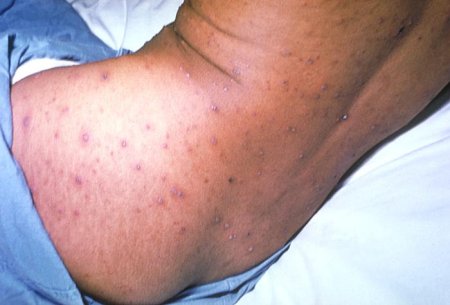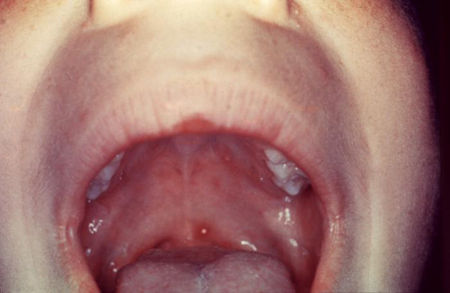Approach
History
Varicella is normally acquired through contact with a patient with chickenpox (or, less frequently, direct contact with herpes zoster), so many patients have a history of such exposure. Exposure among children often takes place in the home, school, or daycare environments. Varicella is contagious with an attack rate of up to 90% in susceptible household members, but attack rates appear to be lower in classroom or daycare environments.[45] A prior history of chickenpox should be ascertained; 4.5% to 13.3% of people with varicella infection report previous varicella.[46] It is also important to review prior vaccination with varicella vaccine. Patients (or parents) may recall a prodrome consisting of fever, fatigue, headache, and/or sore throat, prior to the onset of the rash.
In healthy children, the disease is generally mild and self-limited, with malaise, pruritus (itching), and temperature up to 102°F (39°C) for 2 to 3 days. However, some patient groups are at risk of severe disease and complications such as pneumonia, neurologic sequelae, hepatitis, secondary bacterial infection, and even death. Secondary bacterial infection should be considered in patients with persistent (i.e., >3 days) or recurrent fever.
Children and adults with known immunosuppression, such as caused by malignancy, immunodeficiency, organ transplantation, HIV infection, or corticosteroid use, are at greater risk for complications from varicella infection.[47][48][49] Immunosuppressed patients are more likely to have organ involvement, pneumonia, and hemorrhagic skin disease. While patients with underlying malignancy represent a small number of total varicella events, they account for a large proportion of deaths (up to 50%).[50] In children receiving cancer chemotherapy, 7% of patients died due to primary varicella.[51] Data on immunosuppressed adults is more difficult to ascertain due to the lower incidence of adult varicella, but case reports indicate that these patients are also at greater risk for major complications.[52] Pregnant women without evidence of immunity to varicella are at high risk for severe disease.[53] In addition, women who develop varicella from 5 days to 2 days prior to delivery have a high risk (17% to 30%) of transmitting the virus to their newborn. Because of the absence of maternal immunity to varicella-zoster virus (VZV), these children are at risk for severe infection.[16][54] Premature babies exposed to varicella or herpes zoster may also be at high risk for severe disease, specifically hospitalized premature infants born at 28 or more weeks of gestation whose mothers do not have evidence of immunity and hospitalized premature infants born at less than 28 weeks of gestation or who weigh 1000 grams or less at birth regardless of their mothers’ varicella immunity status.[53]
Physical exam
Patients are often diagnosed by the classic rash associated with varicella. The rash is vesicular and usually first appears centrally (on the face, scalp, or torso), before spreading to the extremities.[55] Classically, lesions are described as "dew drops on a rose petal," vesicular lesions filled with clear fluid and surrounded by erythema. Lesions appear in crops, so that lesions at different parts of the body are in different stages of development.[6] Lesions typically continue to appear over a few days and often are completely crusted over by 7 to 10 days. Vesicular lesions may also be noted in the oropharynx and other mucosal sites. Rarely, varicella can present with a hemorrhagic vesicle or a purpuric rash.[56][Figure caption and citation for the preceding image starts]: Varicella lesions in different stages of healingImage provided by the CDC [Citation ends]. [Figure caption and citation for the preceding image starts]: Varicella lesion on the hard palate of a young patientImage provided by the CDC and the Public Health Image Library [Citation ends].
[Figure caption and citation for the preceding image starts]: Varicella lesion on the hard palate of a young patientImage provided by the CDC and the Public Health Image Library [Citation ends].
Laboratory testing
Clinical findings are usually sufficient to make a diagnosis. In high-risk patients, adults, or other patients in whom the diagnosis is unclear, laboratory testing can confirm the diagnosis.
Polymerase chain reaction testing of skin lesions or cerebrospinal fluid is highly sensitive and will rapidly give an accurate diagnosis.[57]
Culture of vesicular fluid can be utilized to confirm the diagnosis, but may take up to 21 days to become positive. A Tzanck smear of vesicle fluid will show multinucleated giant cells; however, this test is less frequently used for diagnosis, particularly since it is not as accurate as direct fluorescent antibody (DFA) and it is not specific for VZV. Skin scrapings of the base of newer vesicles can be sent for DFA testing, which is rapid and fairly sensitive for the disease.[58]
Serology is not as useful for testing in acute disease, as early testing can be negative. However, serologic testing may be useful in adult vaccination programs, to identify people who do not need to be vaccinated. A variety of serologic tests for varicella antibody are available. Tests include complement fixation, DFA, latex agglutination (LA), and enzyme-linked immunosorbent assay (ELISA). LA should not be used in acute disease, but can be useful in determining seroconversion after vaccination or documenting immune status.[59]
Serology is recommended in pregnant women who have possibly been exposed and have an unknown immune status.[54] If the results are negative or unavailable within 10 days from exposure, varicella-zoster immune globulin (VZIG or VariZIG) should be administered. If immunoprophylaxis is unavailable, oral acyclovir should be given. Ultrasound is recommended for all women who develop varicella in pregnancy, to screen for fetal consequences of infection.[34][60]
In the US, varicella is a nationally notifiable disease.
Use of this content is subject to our disclaimer